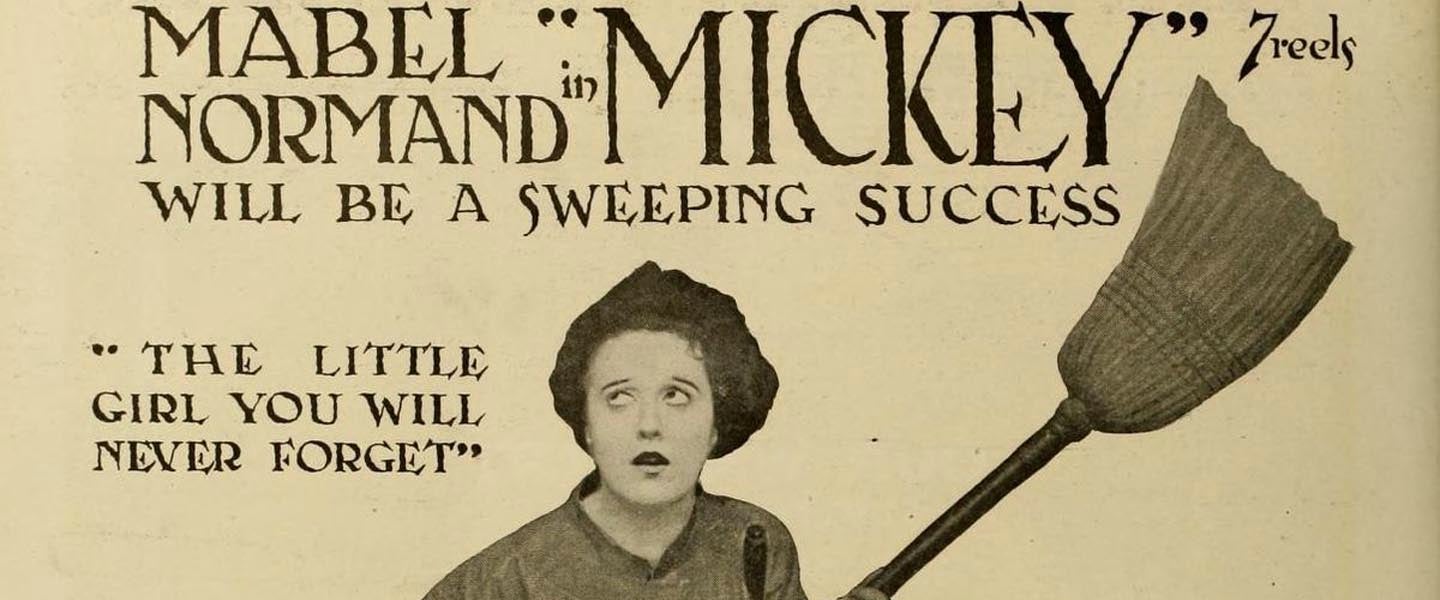When waves of fear crash over me during our current coronavirus crisis, thinking about the 1918 flu pandemic can have a stabilizing effect. Not that what happened back then was a good thing — and you absolutely should not look up “how many died?” without a Klonopin the size of a bar of Irish Spring deodorant soap — but you know what happened after 1918? Nineteen nineteen. And after that? Nineteen twenty. We, too, will survive.
There will, of course, be substantial societal changes. One we’ve already seen is Hollywood sending some of its new releases to streaming on an accelerated or even direct path. The shuttering of theaters happened before, too, and it also had some ripple effects.
Hollywood historian Karina Longworth, creator of the You Must Remember This podcast, recently recorded an “emergency episode” regarding motion pictures and the 1918 flu. From it I learned that, as is currently the case, production on most projects quickly shut down, but before that crews were told to wear masks to set. The somewhat witchy silent-era Theda Bara was photographed not wearing one, and leading man Douglas Fairbanks still allowed his groupies to throng him, earning them both some ill-gotten points for “bravery.”
As with today (get well Idris Elba, Daniel Dae Kim, Tom Hanks and Rita Wilson!) some stars of yore caught the bug. Screenwriter Frances Marion, the hugely popular star Thomas Meighan and young director Frank Capra all got ill and recovered. Lillian Gish is said to have had a fever as high as 106 degrees, but D.W. Griffith still forced her to rehearse for the film Broken Blossoms. Actor Harold Lockwood died of influenza on October 19, 1918.
When the theaters shut down, the independent exhibitors were the ones in most danger of never reopening. According to Longworth, it was in the post-flu haze of 1919 when Adolph Zukor of the newly established Paramount Pictures started aggressively buying out as many closed or on-life-support movie houses as he could find. Paramount then became the first studio to have a substantial production-to-exhibition pipeline. This lasted up until the Supreme Court passed antitrust laws in 1948, colloquially known as the Paramount Decree, though it affected all of the “Big Five” studios of the era.
Thinking about all this, I wondered what specific film, when theaters were open, helped get the American populace get through their crisis. The top movie at the box office, by a substantial margin, was Mickey, starring Mabel Normand, directed by F. Richard Jones and James Young and co-produced by Mack Sennett. Sennett, if you don’t know, originated the Keystone Cops and the Sennett Bathing Beauties, and developed the early careers of Charlie Chaplin, Roscoe “Fatty” Arbuckle, Harold Lloyd and plenty of others.
Mickey was almost a flop, but caught on during a second wave after a theater in Long Island, thanks to a screw-up, had nothing new to show. Though it had run its course, Sennett sent Mickey, which he felt should have caught on, and from there it did, eventually earning $8 million domestically, which is more than $200 million in 2020 dollars.
The film, a comedy, is a vehicle for Normand, a huge star of the era. In fact, the film was the first (and only) title co-produced with Normand’s own company. If you believe TheMabelNormand.com (and why would they lie?), she was the first person in motion pictures to ever receive a pie to the face (as far as I’m concerned, this makes her the Neil Armstrong of physical comedy). She is also credited with being the first damsel tied to railroad tracks. Chaplin considered her a mentor (she even directed one of his early scripts).
For a while, Normand was engaged to Sennett, but the two broke it off. According to lore, when Normand confronted Sennett’s new gal, actress Mae Busch, Busch threw a vase at her head. Normand went into a coma and nearly died. Supposedly, she developed an addiction to cocaine during her convalescence, which led her, years later, to hook up with director William Desmond Taylor, who she thought could help her overcome the problem. He was later found shot dead with a photo of her on him, in a scandalous murder that was never solved. (P.S.: Put the names Mabel Normand and William Desmond Taylor together and that’s how you get Sunset Boulevard’s Norma Desmond. Hollywood!)
Reading about Normand, I felt some sort of seance, from one distraught era to another, was in order. I couldn’t tie on an influenza-protecting kerchief, take the streetcar downtown and buy a ticket for Mickey, but I could do the modern equivalent. In less than 60 seconds, I had a YouTube stream on my medium-sized flatscreen via my several-years-out-of-date-but-still-working Roku. This portal to the past, and Normand’s mound of bushy hair in the title role of a tomboy from California mining territory thrust into high society, was gratifyingly simple to find.
There are three free (and legal?) YouTube streams of Mickey, and all of them are of decent-enough picture quality. There’s an issue with sound however. One of them is completely devoid of music altogether, and I’ll admit that as a man of my era, I find it incredibly difficult to pay attention to even the very best silent movies in absolute silence. (Purists, cast me out if you must!) Another uploader set the film to random classical compositions (Vivaldi and such), which absolutely does not fit. A third uploader had set it to new age spa music, and let me tell you that mugging slapstick from 100 years ago doesn’t gel with sounds I associate with lining up at EPCOT.
I tried watching Mickey in stone cold silence but, in case you haven’t heard, there’s a global pandemic happening. I can barely pay attention to an episode of Robot Chicken right now. “This is hard to do without Scott Joplin’s ‘The Entertainer’ bouncing along!” I cried out to my wife, who, suddenly in quarantine, can now see what I actually do all day. “So put on Scott Joplin’s ‘The Entertainer’!” she called back, always with the answer that’s in front of my face. Through the magic of Spotify and Sonos, I was able to play ragtime piano in ways that eerily synced-up Wizard of Oz/Dark Side of the Moon-style.
Not for nothing, music played a big part in Mickey’s success, despite being a silent picture. A very successful song was written for the film, and a cylinder recording was made.
So, after all that, is the movie any good?
Well, it got me to stop refreshing horrifying news feeds for 93 minutes, so I call that a resounding success! Like most films of the period, it takes a minute to get on its wavelength. It’s odd — in silent movies, sometimes things go soooooooo slowwwwwwly (like a still shot of a letter that lasts long enough to read it 17 times) and then with some of the physical comedy, it’s whip-fast and can still catch you by surprise, even by today’s standards.
Normand’s basic schtick is being something of a lovable “big kid.” There are moments when she’s a klutz (and her enormous mop of hair plays to great comic effect) or she can be somewhat athletic, like racing up the stairs to quickly slide down the bannister when no one is looking. The plot to Mickey is simple enough: Normand is heir to a California mine that seems like a dud, so she is sent back east to live with an uncaring (and unbeknownst to society) broke aunt. Just before she leaves, though, she falls in love with a surveyor. (Mickey has a healthy, lustful appetite that, while never coarse, isn’t hidden either. After an evening of flirtation and a fade-out, the title cards say she had “a night of rosy dreams.”)
There is a love triangle, a series of misunderstandings, some withheld information, a chase scene that involves automobiles that probably go “ah-oooo-ga” that zip in front of trains and also a whole action scene at a race track. It is very far from boring. There are also some classic bits of business, like literally sweeping stuff under the rug, and a sequence centered on a sign that says “No Dogs Allowed.” Clichés came from somewhere, you know.
Through it all, Desmond is an explosion of adorable, wacky faces. There’s a bit where she’s tempted to nibble off a dessert, thinks “naaah!” then says “okay, just a little” until she stuffs some kind of candy (malt balls?) in her mouth. There’s no real joke there, it’s all performance, and it’s terrific.
It’s not a surprise that Mickey was a sensation during a time of great tumult. All the scattered pieces snap together at the end and all the nice people end up happy. Lots of people are dealing with COVID-19 by streaming gruesome true crime documentaries or watching dark shows like The Plot Against America. I certainly understand the inclination to face fear with fear, but there’s something to be said about pure, uplifting slapstick, too. If it got the people of 1918 through their crisis, maybe it can get us through ours, too.

